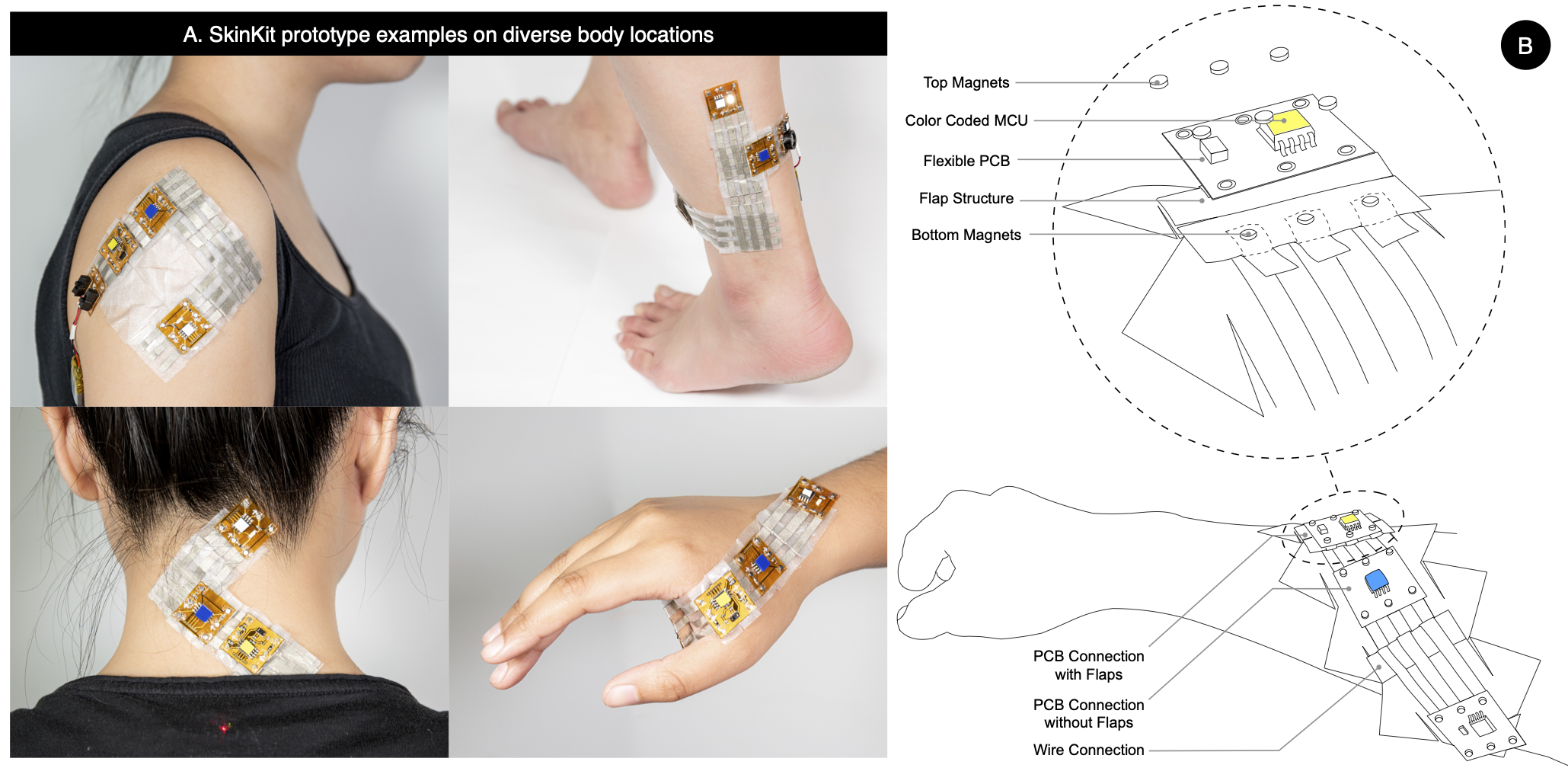SkinKit: Construction Kit for On-Skin Interface Prototyping
SkinKit: Construction Kit for On-Skin Interface Prototyping
We introduce SkinKit, the first modular on-skin interface prototyping toolkit which includes tangible plug-and-play Flexible PCB modules and custom on-skin substrate design for slim, flexible, and quick circuitry routing on the skin, drastically lowering barriers to on-skin interface prototyping.
The emergence of on-skin interfaces has created an opportunity for seamless, always-available on-body interactions. However, developing a new fabrication process for on-skin interfaces can be time-consuming, challenging to incorporate new features, and not available for quick form-factor preview through prototyping. We introduce SkinKit, the first construction toolkit for on-skin interfaces, which enables fast, low-fidelity prototyping with a slim form factor directly applicable to the skin. SkinKit comprises modules consisting of skin-conformable base substrates and reusable Flexible Printed Circuits Board (FPCB) blocks. They are easy to attach and remove under tangible plug-and-play construction but still offer robust conductive connections in a slim form. Further, SkinKit aims to lower the barrier to entry in building on-skin interfaces without demanding technical expertise. It leverages a variety of preprogrammed modules connected in unique sequences to achieve various function customizations. We describe our iterative design and development process of SkinKit, comparing materials, connection mechanisms, and modules reflecting on its capability. We report results from single- and multi-session workshops with 34 maker participants spanning STEM and design backgrounds. Our findings reveal how diverse maker populations engage in on-skin interface design, what types of applications they choose to build, and what challenges they faced.
Publication:
SkinKit: Construction Kit for On-Skin Interface Prototyping
Pin-Sung Ku, Md. Tahmidul Islam Molla, Kunpeng Huang*, Priya Kattappurath*, Krithik Ranjan, Cindy Hsin-Liu Kao (*equal contribution) Proceedings of the ACM on Interactive, Mobile, Wearable and Ubiquitous Technologies (IMWUT) Dec 2021 PDF I DOI
Project Credits: Hybrid Body Lab at Cornell University, directed by Cindy Hsin-Liu Kao
Research Team: Pin-Sung Ku (Lead Researcher), Md. Tahmidul Islam Molla, Kunpeng Huang, Priya Kattappurath, Krithik Ranjan, Prof. Cindy Hsin-Liu Kao
Press Inquiries: Press Image Kit: Download Here (License: CC by-NC-SA 4.0) Press Contact: Prof. Dr. Cindy Hsin-Liu Kao, cindykao@cornell.edu
Press Coverage (Selected):
Cornell Chronicle (11/03/2022): SkinKit offers versatile, wearable on-skin computing
FreeThink (11/13/2022): “SkinKit” lets ordinary people build their own “smart tattoos”
Hackster I/O (11/03/2022): Prototyping of versatile, wearable on-skin computing devices has been made much easier with the modular SkinKit system.
Electronics 360 (11/07/2022): Building an easier “smart tattoo”
India Times (11/05/2022): Lego-Like 'Smart Tattoos' Offer A Glimpse Into The Future Of Wearable Technology
Lifewire (11/15/2022): Skin Computers Could Be the Next Big Thing in Wearables
THIS PROJECT WAS SUPPORTED BY NSF UNDER GRANT IIS#2047249
We introduce SkinKit, a new construction toolkit for on-skin interface prototyping. (a) The modules are made of slim, skin-conformable tessellated base substrates, with Flexible PCB blocks which would be worn on diverse body locations. (b) The SkinKit system. Three-wire module connection types provide flexibility for different body locations. An exploded diagram shows the components mounted onto the PCB and in the wire module. Different types of PCB modules can be distinguished by the color codes.
Skin cloth (a1) design exploded diagram, (a2) photo, and two tessellation designs: (b1) asymmetric and (b2) symmetric.
The SkinKit platform consists of single-function, tangible programming modules that, when attached, create elaborate, interactive behaviors. Drawing from our iterative prototyping observations and related work in functions afforded by existing toolkits and on-skin interactions, our hardware design includes 16 types of FPCB modules, distinguished by different colors: (1) sensor modules (yellow) that sense input and generate data (e.g., light levels, skin temperature, barometric pressure); (2) actuators (white) that consume data and react accordingly (e.g., displays, haptic feedback); (3) modifiers (blue) that transform input signals to other output signals (e.g., blinkers, inverters) (4) power and miscellaneous modules (red), in which miscellaneous includes a DIY electronic module for building with raw electronic components. The dimension of the boards is 2cm in width and length and 0.15mm in thickness.
(a) PCB connection with flaps. (b) PCB connection without flaps. (c) Wire connection. (d) 6 types of circuit units: 5 wire modules and 1 decorative module. (e) Example circuit layout.
Final projects made by the participants: Health and wellbeing (a temperature sensor for detecting changes in body temperature (A) & an atmospheric pressure sensor for detecting deep breaths (B)); Safety (a wearable flashlight when walking/running at night (C) & a proximity sensor to alert the user when someone gets too close (D)); Notification (a device to alert the user of events or surrounding environmental changes (E)); Social (a device for communicating with loved ones or friends (F); Aesthetic/Fashion-driven (an on-skin device aesthetically customized with a beaded trim (G); Dance/Sports Training (a device for on pointe training in ballet).
Example SkinKit interfaces placed on different body locations. (Photo: Hybrid Body Lab)








